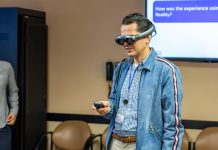It’s no accident that some TED talks have received millions of hits worldwide. What is it that makes a TED presentation so engaging? Why are we driven to watch them again and again? TED talk presenters share one key foundational element—connection. They have the ability to connect effectively with their audience—whether they’re playing an instrument, sharing a technology, presenting a model, or explaining an idea. While there are several reasons for this, let’s explore what I call the five “C” principles. Once you understand what makes a TED talk effective, you can apply these principles to your own presentations.
- Be CONVERSATIONAL. TED presenters remove audience barriers. No lectern. No handheld notes. By facing the audience without physical barriers, a space for open exchange is created. Presenters are free to use full gestures and body movement. This helps their talk appear more like a conversation. Additionally, TED presenters use a conversational delivery style. They use informal language to talk “to us,” not “at us,” so it feels as if we’re listening to someone in our living room. Occasional humor that naturally emerges from the content and situation also help to establish that positive, conversational connection.
- Be CONCISE. TED presenters attempt to not exceed 18 minutes. This imposed limitation requires that non-essential information be excluded. The timeframe demands more preparation than an impromptu talk, but is not long enough to put audiences to sleep. In turn, audience expectations for a shortened framework helps them remain attentive. In the digital age of immediacy, brevity aids audience engagement due to our increasingly shorter attention spans.
- Share COMPELLING content. TED presenters share fresh “ideas worth spreading.” Presenters are passionate about these new ideas and as a result, their passion is contagious and compelling. By weaving true, personal stories into their talks, we also are captivated by the emotional nature of stories and resonate with their compelling, human core.
- Welcome COACHING. TED presenters have rehearsed their talk beforehand—some of them, multiple times. When you watch a TED talk, you are watching a culmination of rehearsal, experience, and expertise. Just as a dress rehearsal for a musical production provides the opportunity to “work out kinks,” the same is true for presentations. Welcoming coaching and feedback from others beforehand will boost your fluidity, confidence, and overall effectiveness.
- Be the CENTRAL messenger. TED presenters are center stage, not their visuals. Our tendency is to surrender center stage to our PowerPoint slides or other visuals. As TED illustrates, presenters should remain the primary messenger and all other surrounding visuals, i.e., videos, photos, slides, and props are just that—supporting visuals. They are used—if at all—to support the message when the content itself calls out for clarity. TED presenters also keep their eye contact mainly on the audience, not exclusively on the visual. Some TED presenters have even successfully presented without any visuals. When TED presenters do use them, visuals are kept simplistically lean to aid audience comprehension and retention.
Remember, you have the ability to apply these principles to your own face-to-face presentations. By keeping your talks conversational, concise, and compelling, welcoming coaching and feedback, and remaining the central messenger, you are well on your way to making an impact by connecting powerfully with your audience.
Diana L. Howles, MA, is owner and president of Howles Associates, a multimedia communication solutions company specializing in visual communication design; powerful presentations; and on-camera, virtual, and in-person delivery. She has been in the training and education field for more than 20 years, and presents at national and regional conferences. Her company offers presentation design courses and consulting grounded in evidence-based adult learning principles. She can be reached at 608.213.6212 or at diana@howlesassociates.com. Follow her blog at dianahowles.wordpress.com or @DianaHowles. For more information, visit http://www.howlesassociates.com.




